Cast iron heating and cooking stoves - features and
Many owners of country houses and country houses, when choosing heating devices, prefer cast-iron heating and cooking stoves. Such a choice can be called quite reasonable, because the level of radiation of heat energy from cast iron is one and a half times higher than that of steel, moreover, this material perfectly accumulates heat. In this article we will take a closer look at what are cast-iron heating cooking stoves, what are their features, as well as how to install these structures.
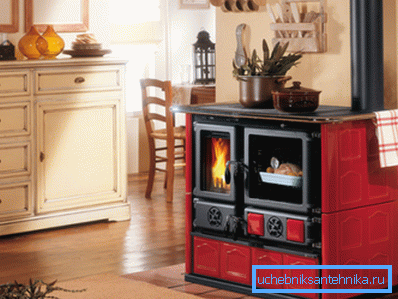
Features of cast iron stoves
Merits
First of all, it should be noted that cast iron is able to heat to very high temperatures without losing its properties. Accordingly, the stoves made of this material will be able to “painlessly” move the firebox not only with firewood, but also with coal, which is one of their main advantages. Steel furnaces in this case can simply burn out and become useless (read also the article Heating and Cooking Stoves with a Fireplace: Features of Choice, Construction and Operation).
Note! Cast iron can not be rapidly cooled, as this can lead to cracking.
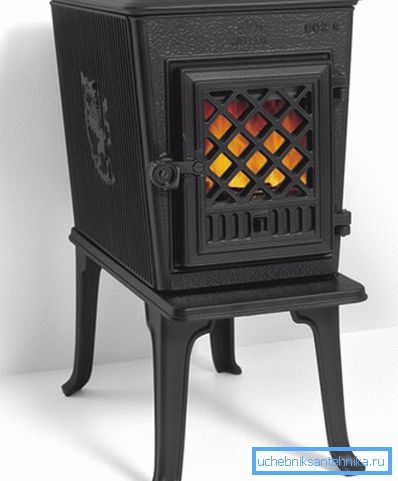
In addition, the stoves of this material have many other advantages, which are listed below:
- Durability - the life of the product is several decades.
- The price of stoves is quite democratic, so we can say that they are available to all homeowners.
- They have a compact size, and as a result they are an excellent choice for small dwellings and country houses.
- Despite the considerable weight, they do not require the installation of a special foundation, unlike stone structures.
- The installation process is quite simple and does not take much time.
- Modern designs of these products allow economical use of fuel.
- Within fifteen minutes after the kindling, the furnace is brought to operating temperature and begins to heat the room.
- Expensive models allow you to adjust the intensity of combustion.
- Attractive appearance, thanks to which the device can also serve as an interior decoration, giving it some solidity.
- Ease of maintenance.
- Cast iron significantly longer than steel retains heat, and also provides a smooth change in the temperature of the surface of the plate when the intensity of the combustion process changes.
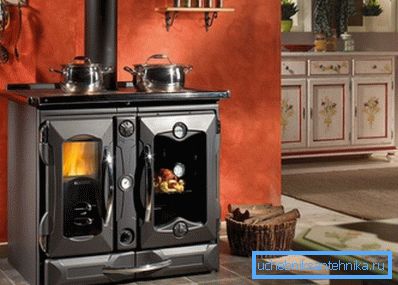
disadvantages
The disadvantages of these devices are few:
- The product can spoil the corrosion, so it is advisable to use such stoves in a dry room.
- For effective and safe operation of the device it is necessary to equip a high chimney.
- Models from foreign manufacturers are usually designed to work on peat and pellets, so they will not be able to use long logs.
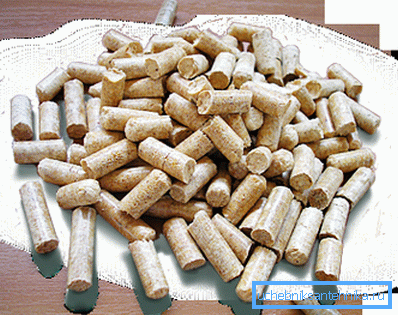
- Spilled water on a hot oven can cause cracks on its surface.
Here, perhaps, all the main disadvantages of these devices.
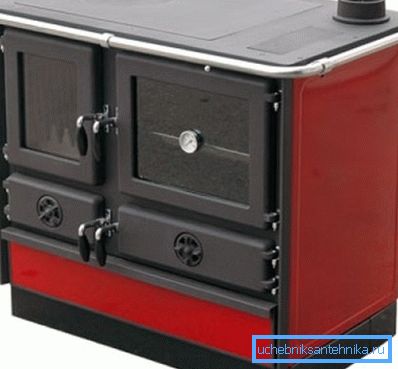
Furnace functions
Heating and cooking cast-iron stoves, as it is not difficult to guess, are designed for space heating and cooking. To do this, they are equipped with a special horizontal plate.
In addition, the design may contain an oven for baking, drying fruits and mushrooms, as well as a compartment for drying wooden ingots. Therefore, before choosing a particular model, you should decide which tasks will be assigned to it. For example, if the product requires only heating the room, then it is more expedient to purchase a stove without a cooking stove, since it takes up less space and costs less.
Tip! If the cooker is located too low, which causes certain inconveniences in cooking, you can make a pedestal for it of a suitable height, for example, from bricks.
Types of designs
Particularly popular for cast iron stoves came in the 19th century. Therefore, many models are made in the style of that time. However, since then the design of these devices has been significantly improved, as a result of which they turned from boxes of firewood into high-tech products.
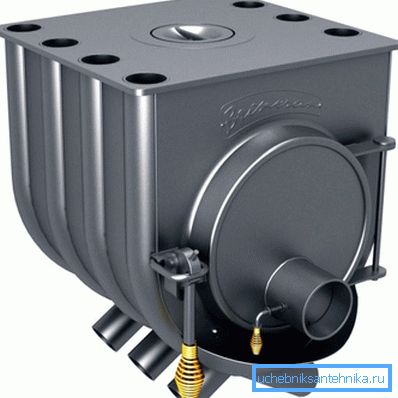
Therefore, before buyers often have a question of choice, what kind of stove to buy? To answer this question, you need to familiarize yourself with all their existing types:
| Single-circuit stove | It is a classic version, in fact, is an analogue of the furnaces of the 19th century. These products can be made in the form of an ordinary stove, and in the form of works of applied art. The latter can serve as an ornament even for prestigious mansions, especially for those styled as antiquities. The relatively low efficiency of these devices (up to 60 percent) is offset by ease of installation and operation. |
| Gas Generation Convection Ovens | These devices can be called the top of the kiln technological art. Their main feature is the presence of two combustion chambers. Wood is placed in the lower fire chamber, where it smolders and at the same time releases gas that rises into the upper fire chamber and burns there. Since the combustion of gas produces more thermal energy than the combustion of wood, the efficiency of such devices can reach 90 percent. Thanks to this design, on one tab, the stove can heat the room for 8-12 hours and serve as a stove for cooking. |
| Fireplace stoves | They represent a rather original design, the firebox of which can be open or closed with tempered glass. Sometimes these devices have two heating circuits. |
It should be noted that in addition, cast iron furnaces may have an automatic fuel supply system and automated control. The operating instructions for these devices are the simplest, however, their cost is very high.
Note! For efficient operation of the stove, the room in which it is located must be well ventilated. Otherwise, oxygen will burn out, which will lead to poor health of the tenants. This is especially important for modern buildings, which are glazed with plastic windows, hermetically insulating the room.
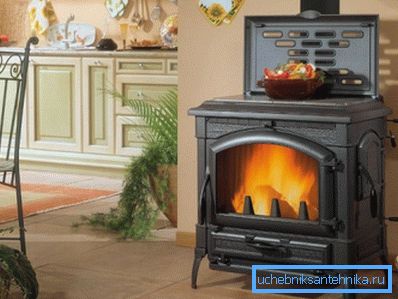
Installation Features
The technique and basic rules for the installation of cast iron stoves are based on existing building codes and regulations. Below in order we consider how to install the structure.
Training
Begin installation with the following preparatory steps:
- The first step is to release the product from the original packaging and carefully inspect. The fact is that cast iron is a fragile material that can be damaged during transportation. Using the device even with small cracks can cause a fire.
- Make sure that all the details of the product are intact, you should check its completeness. As a rule, all attachments during transportation is placed in the furnace.
- If the device is equipped with removable legs, it must be carefully turned over and, according to the manufacturer's instructions, attach all removable supports. After that, the structure should be put on legs and ensure its stability.
- Then you need to check the completeness of the connection of the outlet pipe and chimney. It should be noted that this site is extremely responsible, since the safety of the product operation depends on it. If necessary, you need to purchase an adapter of the appropriate configuration.
Note! When moving the structure, it must be lifted and carried, not dragged, as the legs of the equipment are rather fragile. To move the device, you may need the help of several people.
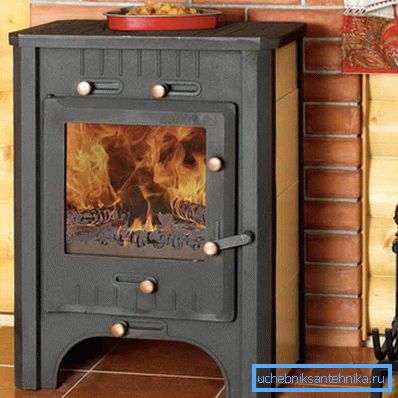
Installation rules
Before making the final choice of location for the installation of the structure, it is necessary to check what materials the surrounding objects are made of. Cast iron stoves are not allowed to be placed near flammable products. At the same time, it is necessary to take into account not only the exterior finish, but also the basic materials of which the walls, floors, furniture, etc. are made.
For example, if there is a wooden wall nearby, which can easily ignite, the chimney should be located at a distance of at least half a meter from its surface. It should also be noted that even from heat-resistant surfaces to the furnace the distance should be at least fifteen centimeters.
At the same time, it is necessary to lay non-combustible materials under the structure itself, for example, a roofing iron sheet or ceramic tile.
Tip! It is advisable to install a curb around the perimeter of the furnace, which will prevent the rolling out of accidentally fallen coal.
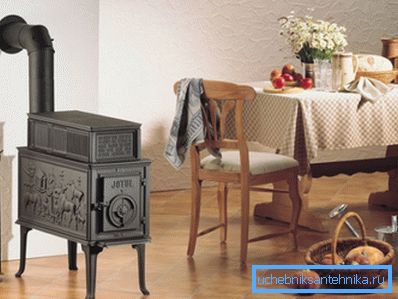
Connecting the stove to the chimney
In fact, the whole installation of the stove with your own hands comes down to the following actions:
- Finding the most suitable place for it;
- Provide a level ground;
- Connected to the chimney.
As mentioned above, the connection to the chimney must be given special attention in order to achieve complete tightness of the connection. First of all, you need to check the quality of the material from which the chimney is made. It should not have visible cracks or cracks.
Of great importance for the efficiency of the flue is the design of the chimney. Its height must be at least four and a half meters from the upper surface of the stove. In this case, the cross section of the pipe must be at least fifteen centimeters.
These parameters must be observed to ensure good traction regardless of the weather. However, the diameter of the chimney should not be excessive, otherwise the fuel will be wasted.
Tip! An adjustable cap can be located inside the chimney, which allows changing the intensity of fuel burning.
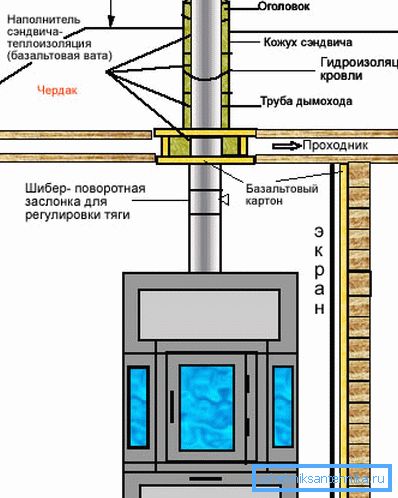
To connect the stove, you need to put a chimney on the nozzle and securely tighten it with a hose clamp. To ensure tightness, if necessary, you can use asbestos cord as a gasket.
After connecting the chimney, it is necessary to melt the furnace and test the system in intensive fire mode. If necessary, the chimney must be equipped with a draft stabilizer. This device will allow you to adjust the intensity of combustion in a wide range.
Here, perhaps, all the main points of the installation of a cast iron stove.
Conclusion
A cast iron heating - cooking stove is not only a fairly efficient heating device that uses solid fuel, but also a stove for cooking. Moreover, the low cost and ease of installation makes it one of the most affordable devices. Therefore, cast-iron stoves were loved by many summer residents and owners of country houses (see also the article Heating and Cooking Brick Ovens - universal devices for a country house).
From the video in this article, you can get more information on this topic.